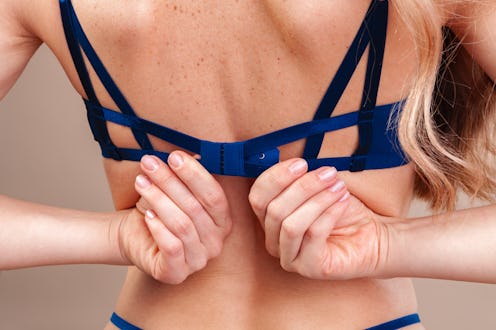Life
All The Germs That Live In Your Bra Right Now & How To Get Rid Of Them

Everybody's guilty of leaving a bra unwashed for days or weeks, because it's just so comfortable, or lies at the bottom of the washing basket, or you just... don't. However, experts tell Bustle that bras come into close contact with skin, nipples, and sweat for long periods, and that means they can often be havens for bacteria. And that means not washing your bra can mean these five kinds of germs flourish — like, really party.
"The mixture of organisms normally found in the inner surface of a bra is the common bacteria found on human skin," Dr. Gretchen Frieling, a dermatopathologist, tells Bustle. "This normal flora consists of fungi, protists, and bacteria, with the latter being the most abundant." This makes sense; our skin produces and houses a lot of bacteria, and anything worn close to the skin will definitely pick up some of it — particularly bras, which are rarely made of breathable or porous materials, and so gather sweat and other things easily.
However, this isn't a sign that you need to give up bras entirely for your skin health, or scrub yourself endlessly every time you wear one. The skin bacteria that gather in your bra, according to dermatologists, is by and large not going to hurt you — but, you do still need to wash your bras regularly. Here are five nasties that might be lurking in your bra.
1Dead Skin Cells
Every time you wear a piece of clothing, your skin sheds onto it. Dead skin cells and skin oil "accumulate onto tightly fitting fabric, such as bras," Dr. Julia Tzu, founder and medical director of Wall Street Dermatology, tells Bustle. That's just a natural part of being human; every day we're estimated to lose 30,000 to 40,000 skin cells, according to the American Association of Dermatologists.
2Staphylococcus
The bacteria that may congregate in your bra, says Dr. Tzu, "may include staphylococcus or corynebacteria". While they sound dramatic — isn't that the bacteria that causes staph infection? — staphylococcus is actually very common on human skin. Our skins have their own microbiomes, or populations of living things, that keeps them healthy and protected, and staphylococcus is one of the most populous of all the bacteria on our skin right now.
Before you panic, this is a good thing. "The normal flora of the skin actually prevents colonization by other disease-causing pathogens, because our bodies' flora limit access and nutrients to these foreign organisms or germs," explains Dr Frieling. The staphylococcus living on your skin are actually a protective barrier, not a terrible plague.
3Corynebacteria
Corynebacteria live not only on the skin but in the microbiome of the stomach, too. By and large, their presence in your bra isn't something to worry about. However, Dr. Frieling explains that they are known to cause acne, so if you're prone to pimples in the areas your bra touches, you may want to change your bras regularly and wash them in soaps that are designed for sensitive skin.
4Streptococcus
Another member of the bacterial family that's likely migrated from your skin to your bra, according to experts, is Streptococcus. Dr. Frieling tells Bustle that Streptococcus pyogenes is the most common kind found on skin. It can cause a host of issues if it becomes an infection, but it can also be benign if found in your normal skin flora.
5Yeast
The moisture produced naturally by the skin throughout the day through sweating also means that you'll likely have some yeast in your bra. Dr. Tzu says pityrosporum is particularly common.
This isn't a problem usually, she says, but if you wear a sweaty bra too often, you may experience yeast issues with your skin. "You might see an asymptomatic yeast infection of the skin known as tinea versicolor, which often presents itself in the central chest and back," Dr. Tzu tells Bustle. It's normally not uncomfortable, but does cause discoloration of the skin. Yeast infections can also develop under the breasts, particularly in people with bigger cup sizes, so if you have a large chest it's a good idea to wash bras regularly.
6
If this list is making you contemplate living in linen tunics and going bra-free for the rest of your life, don't worry. "Overall, these bacteria are a health benefit versus a health risk," Dr. Frieling tells Bustle. The exact formulation of the bacteria in your bra isn't universal, either. "The variation in organisms changes from person to person," Dr. Frieling says. Bacteria populations change, she says, depending on the heat in the environment, moisture on your skin, your age and the pH levels of your skin, plus various other factors.
As long as you are maintaining basic hygienic regimens and keeping your bras clean, your body's bacteria usually protects you from harm.